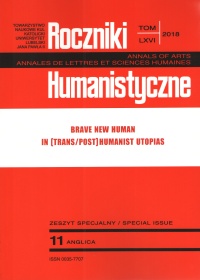A Strange New Harmony: A Posthumanist Utopia in J. G. Ballard’s Crystal World
Abstract
J.G. Ballard’s novel The Crystal World (1966) has been commonly read as a futuristic vision of an apocalypse—a dystopian ending of the human and biological universe precipitated by an unknown and lethal virus that causes climate disturbances and the ensuing crystallisation and freezing of biological life. Read over fifty years after its original publication, the novel seems increasingly less fantastic—given the evident climate change—and, perhaps paradoxically, less apocalyptic. The article analyses Ballard’s novel as an example of posthumanist reflection, arguing that the changes it describes may be interpreted as less of an apocalypse and more of a strange new harmony emerging without the decision or influence of man. The resulting new configuration of power unites human beings with nature and establishes a radically different model of relations between man and universe which may be labelled as a posthumanist utopia.
References
Ballard, J. G. The Crystal World. 1966. London: Flamingo, 2000. Print.
Brigg, Peter. J. G. Ballard. Mercer Island: Starmont House, 1985. Print.
Claeys, Gregory. Dystopia: A Natural History. Oxford: Oxford University Press, 2017. Print.
Clarke, Jim. “Reading Climate Change in J. G. Ballard.” Critical Survey 25.2 (2013): 7–21. Print.
Firsching, Lorenz J. “J. G. Ballard’s Ambiguous Apocalypse.” Science Fiction Studies 12.3 (1985): 297–310. Print.
Hauskeller, Michael. “Utopia in Trans- and Posthumanism.”. Post- and Transhumanism. An Introduction. Ed. Robert Ranisch and Stefan Lorenz Sorgner. Frankfurt-am-Main: Peter Lang, 2014. 101–109. Print.
Hauskeller, Michael. Mythologies of Transhumanism. Cham: Palgrave Macmillan, 2016. Print.
Kermode, Frank. The Sense of an Ending: Studies in the Theory of Fiction. Oxford: Oxford University Press, 2000. Print.
Levitas, Ruth. Utopia as Method: The Imaginary Reconstitution of Society. Houndmills: Palgrave Macmillan, 2013. Print.
Sargent, Lyman Tower. “The Three Faces of Utopianism Revisited.” Utopian Studies 5.1 (1994): 1–37. Print.
Sellars, Simon and Dan O’Hara ,eds. Extreme Metaphors: Interviews with J. G. Ballard 1967–2008. London: Fourth Estate, 2012. Print.
Vonnegut, Kurt. Cat’s Cradle. 1963. London: Penguin, 2008. Print.
Copyright (c) 2018 Roczniki Humanistyczne

This work is licensed under a Creative Commons Attribution-NonCommercial-NoDerivatives 4.0 International License.





